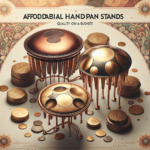<!DOCTYPE html>
<html lang="en">
<head>
<meta charset="UTF-8">
<meta name="viewport" content="width=device-width, initial-scale=1.0">
<title>Exploring Harmonic Textures in Handpan Composition</title>
<style>
body {
font-family: Arial, sans-serif;
line-height: 1.6;
margin: 20px;
padding: 0;
background-color: #f4f4f9;
}
h1, h2, h3 {
color: #333;
}
p {
color: #555;
}
.faq {
background-color: #eef;
padding: 10px;
margin-top: 20px;
}
.faq h3 {
color: #0056b3;
}
</style>
</head>
<body>
<h1>Exploring Harmonic Textures in Handpan Composition</h1>
<p>The handpan is a relatively new musical instrument known for its ethereal sound and enchanting harmonic textures. Emerging from the convergence of percussion and melodic instrumentation, the handpan captivates audiences worldwide. As composers and musicians continue to explore this instrument, they uncover various harmonic textures that offer unique opportunities for musical expression. This article delves into these textures and explores how they can be utilized in handpan composition.</p>
<h2>Understanding Harmonic Textures</h2>
<p>Harmonic texture refers to how different musical notes and sounds are combined in a piece of music. It includes aspects like the melody, harmony, and rhythm that contribute to the overall sound and feel of the music. In handpan composition, mastering harmonic textures can enhance the musical piece's depth, creating an immersive listening experience.</p>
<h3>Monophonic Texture</h3>
<p>Monophonic texture pertains to a single melodic line without accompanying harmonies. In handpan music, this can be accomplished by playing a melody on one note at a time, emphasizing its purity and simplicity. This texture is effective in creating a serene and focused atmosphere.</p>
<h3>Homophonic Texture</h3>
<p>Homophonic texture involves a primary melody supported by harmonic accompaniment. In the context of handpan playing, this is achieved by emphasizing a particular note while adding depth through simultaneous complementary notes. This method allows the melody to shine while the background harmony enhances it, making it a popular choice among musicians.</p>
<h3>Polyphonic Texture</h3>
<p>Polyphonic texture features multiple melodies interwoven, each independently contributing to the overall sound. For handpan compositions, this involves playing different melodic lines simultaneously, creating intricate layers of sound. Mastering polyphonic texture requires skillful coordination and is greatly rewarding, offering a rich auditory experience.</p>
<h3>Heterophonic Texture</h3>
<p>Heterophonic texture occurs when multiple versions of a single melody are played simultaneously. These slight variations result in a complex sound texture, often used in traditional and folk music. In handpan compositions, heterophony can be employed to create subtle intricacies within a seemingly simple melody.</p>
<h2>Building Harmonic Textures in Handpan Composition</h2>
<p>Creating harmonic textures on the handpan involves a combination of several techniques. Here are some elements to consider when composing handpan music:</p>
<h3>Scale Selection</h3>
<p>The handpan is usually tuned to a specific scale that dictates the set of notes available for composition. Choosing the right scale is crucial, as it will define the mood and harmonic language of the piece. Common scales include the D Major and the D Minor, each offering distinct emotional qualities.</p>
<h3>Rhythmic Patterns</h3>
<p>Effective rhythm is key to developing harmonic texture. With the handpan’s percussive nature, varying rhythmic patterns can be applied to create dynamic compositions. Syncopation and polyrhythms can add an intricate layer to the harmonic structure.</p>
<h3>Layering Techniques</h3>
<p>Layering involves stacking different musical elements to build complexity. A handpan player might layer a melody with an accompanying rhythm or harmonize a simple tune with additional notes. This technique develops a rich texture and a more engaging piece of music.</p>
<h3>Dynamics and Expression</h3>
<p>Employing dynamics—varying the loudness or softness of playing—adds expressive quality to the music. By incorporating crescendos and diminuendos, handpan players can accentuate particular phrases or sections, thereby enhancing the harmonic texture.</p>
<h2>Influence of Cultural Music on Handpan Compositions</h2>
<p>The handpan, being a modern instrument, is not bound by traditional music structures. This freedom allows composers to draw inspiration from various cultural music traditions, integrating diverse harmonic textures. For instance, the intricate rhythmic cycles of Indian classical music or the rich harmonics of Middle Eastern maqams can inspire new ways to approach handpan composition.</p>
<h3>Incorporating Eastern Melodies</h3>
<p>Musicians often incorporate pentatonic scales or modes found in Eastern music, which provide a unique sound palette. These scales bring a distinctive feel to handpan compositions, drawing on centuries of cultural expression.</p>
<h3>Fusion Styles</h3>
<p>Blending different musical styles allows for exploration beyond conventional harmoniess. Musicians may combine elements from jazz, blues, or electronic music with traditional handpan playing techniques. This approach expands the potential for creating innovative harmonic textures.</p>
<h2>Conclusion</h2>
<p>Exploring harmonic textures in handpan composition offers endless possibilities for musical expression. Whether opting for a simple monophonic line or an intricate polyphonic arrangement, each texture brings something unique to a composition. Embracing cultural influences further enriches these textures, offering a bridge between tradition and innovation. As musicians continue to explore the handpan's potential, the instrument will undoubtedly reveal even more harmonic depths and inspiring textures.</p>
<div class="faq">
<h3>FAQs</h3>
<p><strong>1. What is the handpan?</strong></p>
<p>The handpan is a steel percussion instrument, crafted to produce notes when struck by hand. It's known for its soothing and melodic sound, resembling that of a steel drum.</p>
<p><strong>2. How does a handpan differ from other musical instruments?</strong></p>
<p>The handpan combines percussion with melodic capabilities, offering a unique tonal and harmonic range. Unlike traditional drums, it produces a lyrical tone, making it popular for solo performances and meditative music.</p>
<p><strong>3. Can anyone learn to play the handpan?</strong></p>
<p>Yes, the handpan is relatively easy to start with due to its intuitive layout. With practice, anyone can develop proficiency and create complex compositions.</p>
<p><strong>4. What scales are commonly used in handpan music?</strong></p>
<p>D Major, D Minor, and Celtic Minor are common scales, each providing distinctive moods and harmonic possibilities for composition.</p>
<p><strong>5. How can harmonic textures be enhanced in handpan music?</strong></p>
<p>Harmonic textures can be enriched through various techniques, such as layering, using dynamic expressions, selecting diverse scales, and incorporating rhythms. Exploring different cultural influences can also broaden harmonic possibilities.</p>
</div>
</body>
</html>Exploring Harmonic Textures in Handpan Composition

Leave a comment




